A search on the Internet elicited a few short mentions and a few
photographs of these fascinating relics from a by-gone age.
Broad Gauge Society Newsletter
Broadsheet 43 Spring 2000
Breakwater Locomotives
"Many harbour breakwaters were built using seven foot gauge
railways. An extensive survey is presented by Derek Brown detailing each line in turn
(including Holyhead and Portland) along with the locomotives known to have worked on them.
The later fate of these locomotives is also covered - they were disposed of to places as
diverse as Brixham and the Azores."
http://www.broadgauge.org.uk/publications/BScontents.html

THE HOLYHEAD BREAKWATER RAILWAY
by Adrian Booth
with photographs and sketch contributions by Frank Jones and Roger Hateley
This article has been reproduced by kind permission of RAILWAY BYLINES
magazine.
Originally published in RAILWAY BYLINES, October 1999, pages 520-527
http://www.holyheadbreakwater.com/RBMag/bylines.htm
http://www.holyheadbreakwater.com/RBMag/locolist.htm

Açores - Broad Gauge Harbor Line
"Some of the locomotives from Holyhead ended up on the Azores.
http://railway-azores.ernstkers.nl/index.htm

Broad Gauge Railway Relics in the Açores
http://www.railways.incanada.net/Azores/Azores.html
http://www.railways.incanada.net/Azores/Azores_locomotives.html

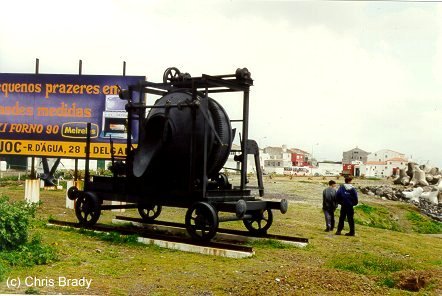 The
Azores harbour line was built in about 1861! Apparently some relics remain even today. The
Azores harbour line was built in about 1861! Apparently some relics remain even today.
Just outside the port of Ponto Delgada on the main island San Miguel there
is a broad gauge cement mixer-type truck on a short length of broad gauge track. Despite
its exposed condition it is in remarkably good condition.
Here are photos I took of it in 1999. |
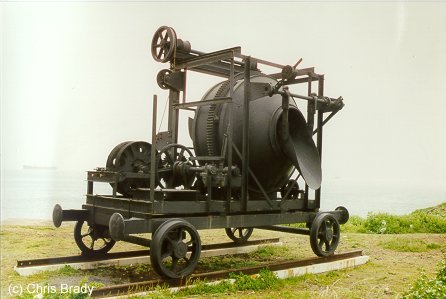
|
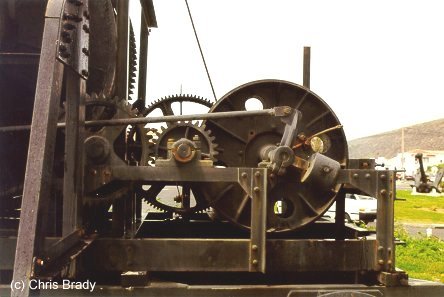 |
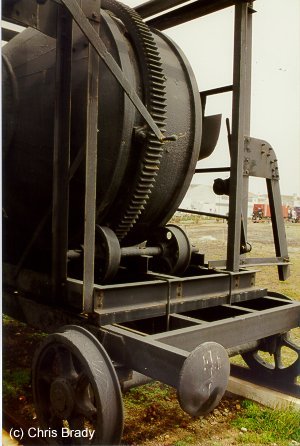 |
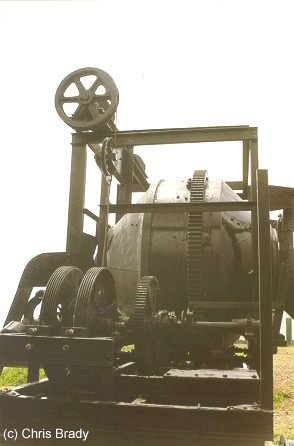 |

Curious as to whether the locomotives are still in existence I emailed the
port authority, Junta Autónoma do Porto de Ponta Delgada. This was the reply:
Relativamente ao vosso e.mail de 27 de Maio
findo informamos que as locomotivas encontram-se nas oficinas desta Junta Autónoma.
Com os melhores cumprimentos
O DIRECTOR DO PORTO,
(José Manuel Pacheco Rego Costa)
I translated this as:
Relatively to your e.mail of 27 of May
We inform that the locomotives meet in the workshops of the Junta Autónoma.
With the best compliments
the DIRECTOR Of the PORT,
(Jose Manuel Pacheco Rego Coast)
I interpreted this to mean that the locomotives are indeed still
in existence in the Port Authority's workshops. A photo of one of them is below!
What we now need to do is try and persuade the Port Authority to put some
more photos onto the web, and also to encourage the Authority to put them on display
somewhere where tourists might see them, and also suggest to them that restoration to
working order would be a good idea. If anyone is visiting the Azores then some more photos
would be great.

There was an article about the possible restoration of at least one of
these locomotives and a short stretch of line at:
http://jornal.publico.pt/
http://jornal.publico.pt/publico/2002/06/11/LocalLisboa/LLP01.html
(link now dead)
A free translation of the article is as follows:
Açores Port Authority to Restore Unique Locomotives
From CARLOS CIPRIANO
Tuesday, 11 of June of 2002
The cost will be 200 thousand euros
But many people ask if the Açores had a railway.
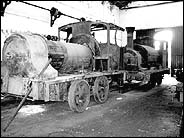 Right now there are two locomotives of immense historical value in a
warehouse in Ponta Delgada where they run the risk of deteriorating due to rust if they
are not preserved. If they are treated and the deterioration is stopped then they can
become a tourist attraction.
Right now there are two locomotives of immense historical value in a
warehouse in Ponta Delgada where they run the risk of deteriorating due to rust if they
are not preserved. If they are treated and the deterioration is stopped then they can
become a tourist attraction.
Two hundred thousand euros are how much the Açores authorities need to find in order
to preserve at least one of these rare machines; rare because they are broad gauge.
The railway of the Açores is practically as old as the first constructed railways on
the Continent. The railway of Ponta Delgada never carried passengers and it was shorter
than 10Kms, but it had a decisive role in the construction of the port, in the 1860s.
At this time, San Miguel was a necessary port-of-call for trans-Atlantic vessels. This
meant that Ponta Delgada had to be developed as a true maritime port, and the authorities
ordered two steam locomotives from England that could run on broad gauge track. This was
the railway system of Brunel, an English engineer who tried, without success, to implement
broad gauge for all railways.
The Açores line left the port where the airport is today, and where the quarries for
the construction of the port existed at that time - and it followed the edge of the shore
until it was just west of Ponta Delgada.
The two machines had towed, between 1862 and 1888, loaded trains of rock, and the work
was quickly completed. After World War 2, in a new phase of economic expansion for San
Miguel, the locomotives came back into use, this time to help with the construction of the
road from the fort of San Brás to Calheta, between 1948 and 1954.
In the late 1960s Ponto Delgada came to hear the whistle of the locomotives again, this
time for the works to extend the pier of the port. But the railway would cease in 1973,
when the old machines, already then over 100 years old, had whistled for the last time
when transporting the gravel. During the last 20 years the locomotives had been on display
in the garden of the Museum Carlos Axe, but they were then moved into the warehouse of the
Port Authority of Ponta Delgada.
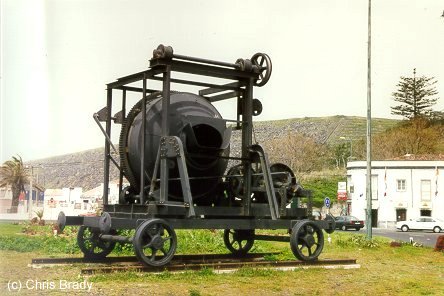 In 1994, a specialist British Engineering company travelled to the Açores,
at the invitation of the Regional Director of Cultural Subjects, to study the recovery of
the machines, the only remaining broad gauge ones in the world built to the 7 foot gauge.
Only in England, the cradle of railways, is there a replica of a broad gauge locomotive of
this type.
In 1994, a specialist British Engineering company travelled to the Açores,
at the invitation of the Regional Director of Cultural Subjects, to study the recovery of
the machines, the only remaining broad gauge ones in the world built to the 7 foot gauge.
Only in England, the cradle of railways, is there a replica of a broad gauge locomotive of
this type.
The authorities of the Açores refused the proposal of the English to restore the two
machines under the condition that one of them remains in England. The Company of
Maintenance of Equipamento Ferroviário (EMEF), branch office of the CP, has stated that
it would take 200 thousand euros to restore one of them. "We want to assume the
responsibility of a project that reflects a golden period of Ponta Delgada", declares
José Rego Costa, of the Junta Autónoma dos Portos. The debate is now the problem of the
financing of the restoration of the machines. "If it depended on me, I would make a
small railway with a covered carriage for tourists to run around the port".
António Manuel Oliveira, director of the Museum Carlos Axe, of Ponta Delgada, also
supports the project to reinstate the railway to the quayside for tourists to use to
travel exactly where the locomotives used to function long ago". But the project
would have to be carried out in connection with a future museum of the History of the
Commerce, for which it is necessary still to persuade some departments of the regional
government to support.
![]()
![]()